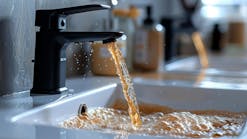Updated 3/23/21
What is Resin Regeneration
The basic purpose of resin regeneration is to restore the exhausted resin back to its proper ionic form for service. Although there are various manuals and sources that contain information on how to regenerate resins, for many, guessing plays a major role in this process. To eliminate the guess factor from the resin regeneration equation, this article will provide an overview of the basic regeneration procedures and guidelines for softeners and two-bed deionizers.
Softeners
The end of a softener service cycle is determined either by a timed service run, total gallon throughput, or a high measure of hardness in the softener effluent. A four-step regeneration sequence is then performed.
1. Backwash Cycle. The backwash cycle expands the resin bed from its settled and packed condition, and cleans the resin by flushing out any suspended solids that may have been filtered during the service run. Resin particles can act as effective filter media because they have ionic charges, which can coagulate fine particles. During the backwash, the resin beads rub against each other, and this scrubbing action helps clean accumulated dirt or iron from the surface of the beads. The backwash flow also removes any broken resin particles or resin fines. In addition, the backwash cycle classifies the bed with the larger resin beads on the bottom and the finer resins on top. This provides the best conditions for a good uniform flow of brine, rinse and service.
It is desirable to expand the softener resin bed about 50% and to have the duration of the backwash cycle long enough to effectively remove all of the resin fines and other suspended solids. At ambient temperatures (about 60°F), using standard softening cation resin and a flow rate of 6 gpm per square foot of surface area for a duration of 10 to 15 minutes is sufficient. It is very important to consult manufacturers’ literature for the specific resin being regenerated to find the correct backwash flow rate. The backwash flow rate is dependent on temperature; cooler water expands the bed more than warmer water.
2. Brine Introduction. Sodium chloride is used as the regenerant chemical for converting exhausted softener resin back to the sodium form. The resin exchanges the collected hardness on the bead with the sodium ion present in the sodium chloride. It is applied to the bed at a concentration of 8 to 12%; usually, 10% is the norm. A contact time of 30 minutes is desirable. The total contact time is calculated from the time the brine is introduced to the bed until it is displaced from the bed during the slow rinse. Salt dosage range is 6 to 15 lb per cubic foot.
3. Slow Rinse. The slow rinse or displacement step removes from the bed the volume of brine regenerant that is still in the vessel. This is the most pure brine that the resin will come into contact with, so it is important not to flush it out too quickly. During the slow rinse cycle, the valve from the concentrated brine is shut, and only the dilution water is introduced to the bed at the dilution water flow rate. It helps if the dilution water and the slow rinse water are from a softened water supply.
4. Fast Rinse. The final step is a fast rinse, and it is performed at the service flow rate. The fast rinse step removes any residual brine from the resin beads and helps flush out any brine that may be present in dead areas of the tank. The minimum recommended flow rate is 1 to 1.5 gpm per cubic foot.
The Regeneration of Cation and Anion Exchange Resins
The regeneration of cation and anion exchange resins used in deionizers is a more complicated process than simple softening. The process includes the use of strong acid and caustic. It is important to observe the appropriate safety considerations for handling these chemicals and the resultant waste products.
A strong acid cation unit exchanges calcium, magnesium and sodium, etc., with its active ions, hydrogen. The strong base anion unit in a two-bed deionizer exchanges sulfate, chloride, alkalinity and silica ions with hydroxide. This slowly reduces the concentration of available active ions. The resin is considered exhausted when the active ion concentration reaches a low level, and effluent has a pre-selected high leakage of unexchanged ions, known as endpoint leakage. This leakage is usually indicated by a conductivity setpoint.
1. Backwash. During the service cycle, the resin bed collects suspended impurities from water. Some of the media particles/beads can break up into fines, and the bed becomes somewhat compacted. Introducing water at calculated flow rates in the opposite direction to the service flow lifts the bed, which loosens up and expands into the free board. This forces the suspended particles and media fines out of the unit. At the same time, the bed loses its compaction, reducing the likelihood of channeling, which could cause water or regenerant chemicals to bypass some of the effective media bed. Compaction and fines also cause excessive pressure drop.
Water of the same quality as the influent is introduced from the bottom of the vessel, collected at the top and then directed to the drain. Proper backwash rate is of great importance since rates higher than suggested may cause media loss, and lower rates may not be sufficient to complete the backwash properly. Any sudden shock in the backwash cycle should be avoided, as this may cause media loss.
Consult the resin specification sheets for the proper backwash flow rate because cation and anion resin densities are quite different. Generally, cation backwash flow rates are in the range of 6 gpm per square foot of surface area, and the anion backwash flow rate is about half of that.
2. Regenerant Introduction. Regenerants of proper concentration are introduced into the tanks to reactivate the resin. The strength of dilute regenerant and its flow rate are of utmost importance. Any change in these values compared to the ones specifically suggested may cause resin fouling, capacity loss and quality deterioration. In some cases, the regenerant has to be heated to a specific temperature to complete a proper elution. (Elution is the stripping off of exchanged ions.)
Acid application to cation resin. The strong acid cation exchanger resin is regenerated with sulphuric or hydrochloric acid, which effectively strips off the calcium, magnesium and sodium from the resin, substituting hydrogen. Hydrochloric acid is typically applied at between 4 and 6%.
If dilute sulfuric acid is used, the percent concentration is often applied in a stepwise fashion; for instance, the first half of the dosage is applied at 2% and the second half at 4%. The exact concentration of sulfuric used is calculated from the amount of calcium that is present in the water being treated during the service cycle. Because the resin is removing and concentrating calcium ions, a potential for the precipitation of calcium sulfate exists when the sulfuric acid is applied.
The contact time for the acid regenerant introduction should be around 30 minutes, and the flow rate should be about 0.5 to 1 gpm per cubic foot. (When using sulfuric acid, it is wise to design around the high end of the recommended regenerant flow rate.)
Caustic application to anion resin. Caustic soda, or sodium hydroxide (NaOH), is used to regenerate the anion resin. A concentration of 4% is applied at a flow rate between 0.25 and 0.5 gpm per cubic foot. A contact time of 45 minutes minimum, 60 minutes preferred, is required.
The anion resin exchanges off the collected anions for the hydroxide (OH) ion in the caustic. Any collected silica needs to be re-dissolved off of the resin, and this is facilitated by time and temperature. That is why the 60-minute contact time is indicated. Also, it is important to elevate the temperature of the dilute caustic to 120°F for type 1 anion resins (95°F max for type 2).
3. Displacement (Slow) Rinse. The process of displacement of regenerants and the eluted ions from the resin is started at a slow pace, normally at the same flow rate at which the dilute regenerant was introduced.
4. Fast Rinse. After the slow rinse, the resin is rinsed further at a higher flow rate. Rinsing removes the excess regenerant from the resin. At the same time, all of the eluted ions are displaced from the resin bed, bringing the resin back to active condition, ready to be put into service.
There are various factors that can affect the outcome of resin regeneration. Hopefully, this article will eliminate guesswork and help you better understand the overall regeneration process.



